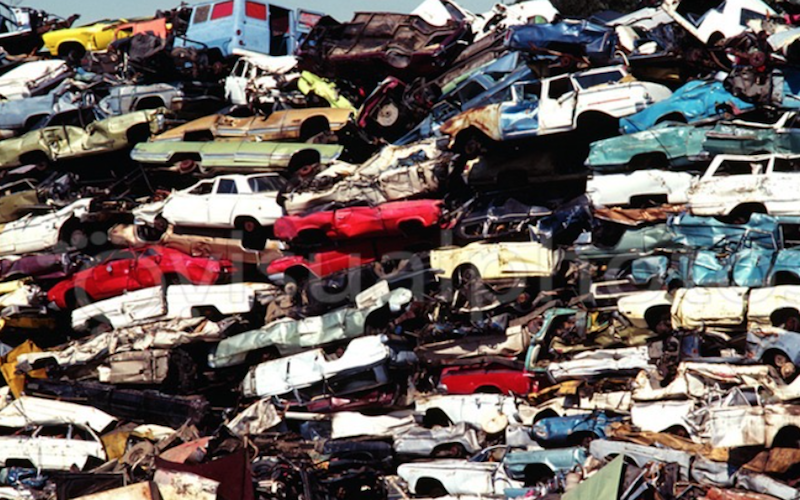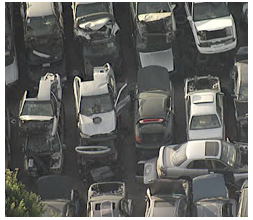CommentsEASTSIDER-Over the holidays is a great time for politicians to announce things that would normally get greater scrutiny during the year. After all, everyone is making family get together plans, traveling, and/or hiding from year end duties. In that context, along comes a Report from the City Controller with the spiffy name “Disposition of City’s Surplus or Obsolete Items and Equipment” and I lick my chops because I just know that there’s going to be some real gems buried within.
The Controller’s audit report does not disappoint. The headlines in it say that the City isn’t monitoring its fleet vehicle system, and is spending more money than many of the vehicles are worth in maintenance. For cars there is a photo of a Civic Hybrid that cost $24,000 (new) but they have spent $44,000 to maintain and repair it. On the big iron Street Sweeper side, there’s a photo of one that cost $232,000 to buy -- but another $360,000 to maintain.
Buried in the document, however, is a story that really interests me: back in 2011, Tony V’s City was broke due to the Mayor and the Council’s incompetent fiscal policies. They were desperate to make the budget look balanced. So, through a series of cuts, early retirements, and shifting employees to DWP and the like, they cooked the books enough to get a bond measure through and stay “solvent.”
One of the brilliant ideas the Council had was to disband the General Services Department’s Salvage Section -- the folks who monitored the disposCWal of the City’s surplus and/or obsolete items. So guess what happened? Not much, and that’s the essential finding of how and why the City has no real system and has lost a bunch of money. Gee.
The audit misses a fundamental understanding of how and why LA City’s bureaucracy operates the way it does, and the implications therein. At the top of the food chain are the elected officials, who, by current definition, make political decisions regarding oversight of the City. They do not make business decisions, unless you count getting developers, billboard companies, and the like to make campaign contributions to their coffers.
I point this out to explain the impact of the City Council’s actions as they axed or crippled, year after year, every request by City Departments for vehicle replacement – and abandoned all oversight.
So when these half-baked mandates trickle down to the troops, there is one lesson that almost every vested City employee has learned well: as long as you “go along to get along” and don’t make waves, you will have a fine future and a pension with the City of Los Angeles. On the other hand, if you make waves, take risks, or (god forbid) make the elected officials look bad, your life will be very unpleasant indeed.
Consequently, no one said anything.
Looking at the guts of the audit, there are two fundamental lessons to be learned. First, over 80% of the money we are talking about comes from cars -- vehicle fleet maintenance, which represents 83% of all auction income, to be exact.
Second, outside of vehicles, no one department or agency has responsibility or understanding of exactly what, if any, policy the City has regarding the sale or disposal of obsolete property. Thus it is hard to quantify the rest of the items discussed in the audit; they aren’t even tracked internally, or if they are, it’s by happenstance.
For example, electronic equipment has its own website (CitiMAX) which almost no one uses. Most of the stuff that gets donated through it (surprise) is because of City Council requests, and even then, the amount of paperwork involving formal Council action is not cost effective.
I am personally aware of this and remember well when the Glassell Park NC tried to get the City to cough up a computer for our use. No deal. And when the NC used its own funds to buy one, we had to comply with all the CitiMAX requirements of inventory, serial numbers and other information and justification. And now we know all this data went nowhere. So, well done, DONE, BONC and Council offices – thanks a lot.
If there is a single takeaway moment in the report, for me it is the following: the auditor complained that, as they tried to obtain data, they were reduced to looking at individual employees’ Excel spreadsheets that didn’t even have a common template. Clearly, the Mayor’s “World Class City” is an emperor without clothes.
The final report has a six point series of recommendations that require action by the Council and City Departments, although there is no reason to believe those points will survive the City Council budget process. For a copy of the full report, click here.
For those of you with a mathematical bent, Pareto’s Principle is alive and well – 80% of the dollars comes from about 20% of the stuff. In line with this concept, I propose a variation on this idea -- two simple recommendations that would fix 80% of the problems identified in the audit:
1) Reconstitute the Salvage Unit, staff it with competent people, give them citywide authority and responsibility.
2) Hire a couple of “freelance” thirty-somethings or their equivalent (that is, no regular full-time employment), pay them enough to cover wages and benefits, then have them develop a simple, web based, data management system for centralizing everything that needs to be kept track of. Then make everybody use it.
This would be simple and quick with a provable return on investment model. I suggest this be done immediately because, given their mind set, City Council is likely to come up with some stupid major IT project that they would then bid out to the usual “big name/bad result” corporate consultants…who contribute to their campaigns.
Stay tuned...
(Tony Butka is an Eastside community activist, who has served on a neighborhood council, has a background in government and is a contributor to CityWatch.) Edited for CityWatch by Linda Abrams.
-cw
CityWatch
Vol 13 Issue 104
Pub: Dec 25, 2015
Explore
Our mission is to promote and facilitate civic engagement and neighborhood empowerment, and to hold area government and its politicians accountable.

 CityWatch Los Angeles
Politics. Perspective. Participation.
CityWatch Los Angeles
Politics. Perspective. Participation.
11
Fri, Apr
















